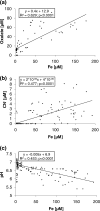Weathering-associated bacteria from the Damma glacier forefield: physiological capabilities and impact on granite dissolution
- PMID: 20525872
- PMCID: PMC2901745
- DOI: 10.1128/AEM.00657-10
Weathering-associated bacteria from the Damma glacier forefield: physiological capabilities and impact on granite dissolution
Abstract
Several bacterial strains isolated from granitic rock material in front of the Damma glacier (Central Swiss Alps) were shown (i) to grow in the presence of granite powder and a glucose-NH(4)Cl minimal medium without additional macro- or micronutrients and (ii) to produce weathering-associated agents. In particular, four bacterial isolates (one isolate each of Arthrobacter sp., Janthinobacterium sp., Leifsonia sp., and Polaromonas sp.) were weathering associated. In comparison to what was observed in abiotic experiments, the presence of these strains caused a significant increase of granite dissolution (as measured by the release of Fe, Ca, K, Mg, and Mn). These most promising weathering-associated bacterial species exhibited four main features rendering them more efficient in mineral dissolution than the other investigated isolates: (i) a major part of their bacterial cells was attached to the granite surfaces and not suspended in solution, (ii) they secreted the largest amounts of oxalic acid, (iii) they lowered the pH of the solution, and (iv) they formed significant amounts of HCN. As far as we know, this is the first report showing that the combined action of oxalic acid and HCN appears to be associated with enhanced elemental release from granite, in particular of Fe. This suggests that extensive microbial colonization of the granite surfaces could play a crucial role in the initial soil formation in previously glaciated mountain areas.
Figures





References
-
- Anderson, S. P., J. I. Drever, C. D. Frost, and P. Holden. 2000. Chemical weathering in the foreland of a retreating glacier. Geochim. Cosmochim. Acta 64:1173-1189.
-
- Barker, W. W., S. A. Welch, S. Chu, and J. F. Banfield. 1998. Experimental observations of the effects of bacteria on aluminosilicate weathering. Am. Miner. 83:1551-1563.
-
- Bennett, P. C., J. R. Rogers, and W. J. Choi. 2001. Silicates, silicate weathering and, microbial ecology. Geomicrobiol. J. 18:3-19.
-
- Bernasconi, S., and BigLink Project Members. 2008. Weathering, soil formation and initial ecosystem evolution on a glacier forefield: a case study from the Damma Glacier, Switzerland. Miner. Mag. 72:19-22.
Publication types
MeSH terms
Substances
Associated data
- Actions
- Actions
- Actions
- Actions
- Actions
- Actions
- Actions
- Actions
- Actions
- Actions
- Actions
- Actions
- Actions
LinkOut - more resources
Full Text Sources
Research Materials

